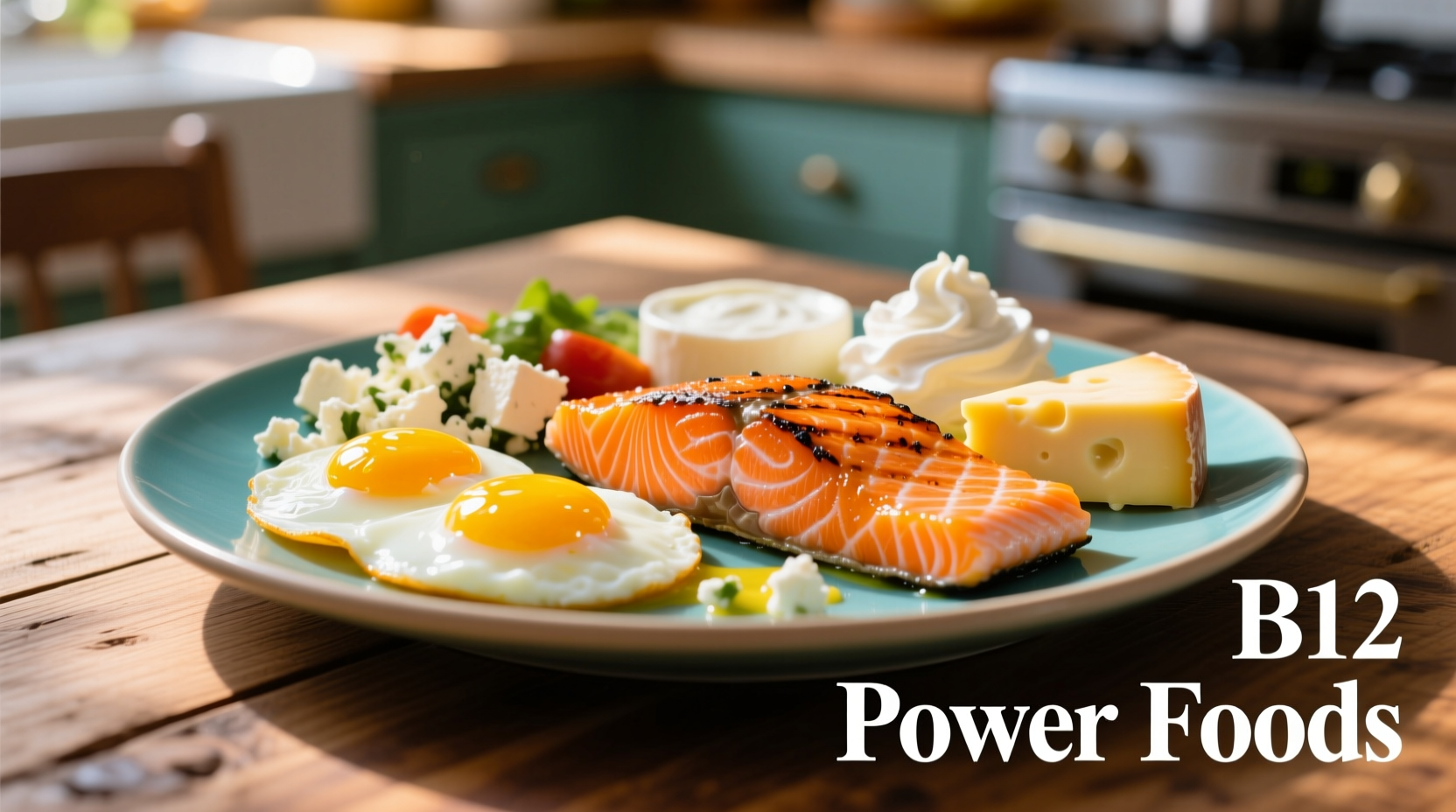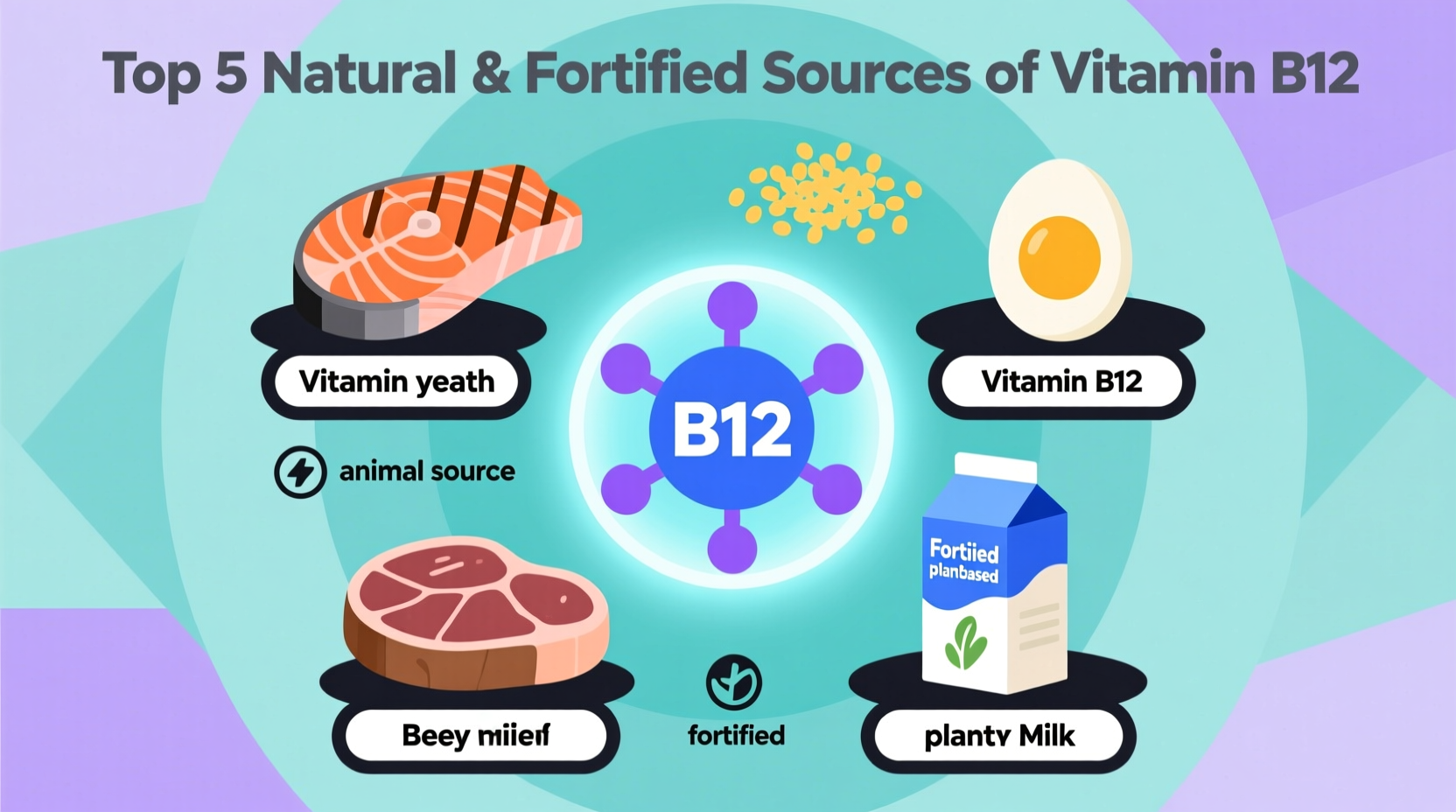Vitamin B12 is found naturally in animal products including beef liver (70.7 mcg per 3 ounces), clams (84 mcg per 3 ounces), salmon (4.9 mcg per 3 ounces), and eggs (0.6 mcg per large egg). For vegetarians and vegans, fortified foods like nutritional yeast (2.4-7 mcg per tablespoon), plant milks, and breakfast cereals provide essential B12. The recommended daily intake ranges from 0.4 mcg for infants to 2.4 mcg for adults, with higher needs for pregnant and breastfeeding women.
Discover exactly which foods deliver this critical nutrient and how to incorporate them into your diet for optimal health. Whether you're omnivore, vegetarian, or vegan, this guide provides science-backed information to prevent deficiency and maintain neurological function, red blood cell formation, and DNA synthesis.
Why Vitamin B12 Matters More Than You Think
Vitamin B12 (cobalamin) isn't just another nutrient—it's essential for three critical bodily functions: neurological health, red blood cell production, and DNA synthesis. Unlike other vitamins, your body can't produce B12 naturally. You must obtain it through dietary sources or supplementation. Deficiency can cause irreversible nerve damage, anemia, and cognitive decline—often developing silently over years before symptoms appear.
According to the National Institutes of Health, approximately 6% of adults under 60 and up to 20% of those over 60 are deficient in vitamin B12. The risk increases significantly for vegetarians, vegans, and individuals with gastrointestinal disorders that impair absorption.
Natural Animal-Based B12 Powerhouses
For omnivores, these animal-derived foods deliver the most bioavailable form of vitamin B12. The following table shows verified B12 content from USDA FoodData Central:
| Food Source | Serving Size | B12 Content (mcg) | % Daily Value |
|---|---|---|---|
| Clams | 3 ounces | 84.1 | 3,504% |
| Beef liver | 3 ounces | 70.7 | 2,946% |
| Trout (wild) | 3 ounces | 5.4 | 225% |
| Salmon | 3 ounces | 4.9 | 204% |
| Tuna | 3 ounces | 2.5 | 104% |
| Beef (lean) | 3 ounces | 1.5 | 62% |
| Low-fat milk | 1 cup | 1.2 | 50% |
| Yogurt | 1 cup | 1.1 | 46% |
| Cheese (Swiss) | 1 ounce | 0.9 | 38% |
| Eggs | 1 large | 0.6 | 25% |
Notice that organ meats like liver provide extraordinary amounts—just one 3-ounce serving delivers nearly 3,000% of your daily needs. For regular consumption, fatty fish like salmon and trout offer excellent daily options with additional omega-3 benefits.

Plant-Based B12 Solutions for Vegetarians and Vegans
Since natural B12 doesn't exist in plant foods, vegetarians and vegans must rely on fortified options. The following provide reliable sources:
- Nutritional yeast: 2.4-7 mcg per tablespoon (often fortified)
- Fortified plant milks: 0.5-3 mcg per cup (almond, soy, oat)
- Breakfast cereals: 0.6-6 mcg per serving (check labels)
- Fortified meat substitutes: 0.6-3 mcg per serving
- Some fortified nutritional supplements
According to the Academy of Nutrition and Dietetics, vegans must regularly consume fortified foods or supplements to meet B12 requirements. Unlike animal sources where B12 is bound to protein, fortified foods contain free B12 that's actually more readily absorbed.
How Much B12 Do You Really Need?
Daily requirements vary by life stage. The National Institutes of Health provides these official recommendations:
- Infants (0-6 months): 0.4 mcg
- Infants (7-12 months): 0.5 mcg
- Children (1-3 years): 0.9 mcg
- Children (4-8 years): 1.2 mcg
- Children (9-13 years): 1.8 mcg
- Teens and adults (14+ years): 2.4 mcg
- Pregnant women: 2.6 mcg
- Breastfeeding women: 2.8 mcg
These values represent the minimum to prevent deficiency, but many nutrition experts recommend higher intake for optimal health, especially for those with absorption issues. The NIH notes that no adverse effects have been reported from excess B12 intake from food or supplements.
Critical Factors Affecting B12 Absorption
Getting B12 into your diet is only half the battle—your body must absorb it properly. Several factors impact absorption:
- Intrinsic factor: A stomach protein essential for B12 absorption. Autoimmune conditions can destroy cells that produce it.
- Age: Up to 30% of adults over 50 have reduced stomach acid, impairing B12 release from food.
- Gastrointestinal surgery: Procedures like gastric bypass reduce absorption capacity.
- Medications: Long-term use of proton pump inhibitors (PPIs) and metformin can interfere with absorption.
For those with absorption issues, crystalline B12 from fortified foods or supplements provides better bioavailability than food-bound B12. The NIH reports that 56% of a 1 mcg dose is absorbed in healthy individuals, but this drops significantly with higher doses.
Practical Daily B12 Integration Strategies
Instead of worrying about precise measurements, incorporate these simple habits:
- Breakfast boost: Choose fortified cereal with plant milk (provides 100-150% DV)
- Lunch addition: Sprinkle 1 tbsp nutritional yeast on salads (provides 100% DV)
- Dinner focus: Include 3 ounces of salmon or trout (provides 200% DV)
- Snack smart: Enjoy Greek yogurt with berries (provides 50% DV)
For omnivores, rotating between different animal sources ensures variety while meeting needs. Vegetarians should combine dairy/eggs with fortified foods. Vegans require consistent fortified food consumption or supplementation—don't rely on spirulina or fermented foods, which contain inactive B12 analogs that can actually interfere with absorption.
When to Consider Supplementation
Supplementation becomes necessary in these scenarios:
- Vegans not consuming fortified foods regularly
- Individuals over 50 with reduced stomach acid
- Those with pernicious anemia or gastrointestinal disorders
- People taking long-term medications that impair absorption
- Post-bariatric surgery patients
The American College of Physicians recommends daily oral supplementation of 25-100 mcg for older adults and higher doses (1,000 mcg) for those with diagnosed deficiency. Sublingual forms offer no absorption advantage over oral supplements for most people.
Recognizing B12 Deficiency Early
Early symptoms often mimic other conditions, making deficiency hard to detect. Watch for:
- Unexplained fatigue and weakness
- Numbness or tingling in hands and feet
- Mood changes including depression
- Memory problems and cognitive difficulties
- Pale or jaundiced skin
- Sore, red tongue
If you experience these symptoms, consult a healthcare provider for proper testing. The Mayo Clinic emphasizes that blood tests measuring serum B12, methylmalonic acid (MMA), and homocysteine provide the most accurate diagnosis.











 浙公网安备
33010002000092号
浙公网安备
33010002000092号 浙B2-20120091-4
浙B2-20120091-4